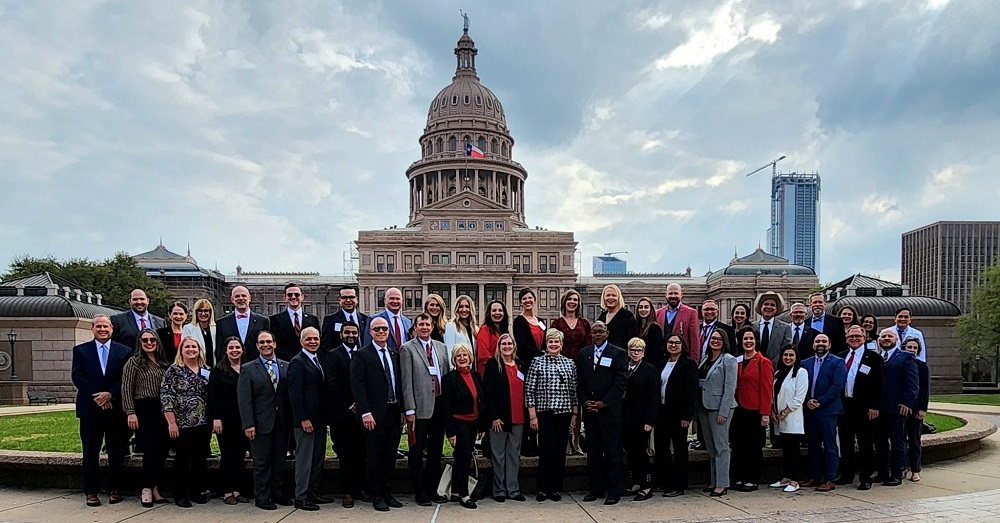The TTUHSC Community brought their passion for expanding telehealth to Austin

Last month, 30 faculty, students and scientists from Texas Tech University Health Sciences Center (TTUHSC) arrived at the Texas capitol to celebrate the university’s accomplishments and promote their priorities to Texas legislators. The top item: expanding telehealth for the rural Texans whose lives could drastically improve with access to health care.
“That is our top priority moving forward,” said Smiley Garcia, Senior Director of Governmental Relations at TTUHSC. “It is an actual budget request and has been submitted to the legislature in Austin.”
The Request
TTUHSC requested $6.75 million per fiscal year and $13.5 million for the next two years for the establishment of the Institute for Telehealth Technology and Innovation. The institute will focus on three main pillars: access to care, expanding research and academics.
The successful funding for this initiative would be cause for celebration for more than just the university—it would mean a future of reliable health care for people across the state who are currently struggling to get the care they need.
Growing Access to Care
Many rural areas in West Texas provide the food, fuel and fiber that allow Texas to thrive. Yet despite its national significance, the area is predominantly underserved in terms of critical health care.
TTUHSC President Lori Rice-Spearman, Ph.D., pointed out that by continuing to expand and grow telehealth capabilities, a telehealth institute would lessen the current gap in health disparities across West Texas.
“What this ask will do is it will allow us to go into the rural communities that we support and find ways to further support them so that we can continue to grow access to care,” said Rice-Spearman. “We’ll work with our communities by going and asking them: what do you need? How can we continue to grow your access?”
Garcia explained that expanding clinical reach via telehealth is also about the Correctional Managed Health Care program at TTUHSC, which serves nearly 40,000 inmates in 27 correctional facilities across the region. This could improve health and safety for inmates and civilians alike.
“When you’re providing health care in a correctional landscape,” Garcia said, “you really want to minimize the potential transport of inmates to civilian hospitals. So we can try to take care of as much of that as possible in house.”
Expanding the Reach of Research
By strengthening the research component of telehealth, TTUHSC can work to analyze and examine clinical efficacy and health care outcomes across the board.
“This means evidence-based research on telehealth and digital health: if it’s appropriate for treatment of certain diseases, or if it’s not,” said Rice-Spearman.
The practice of telehealth can be used for more than just a routine checkup—and the more research is put into this practice, the more technology there will be to offer.
“One thing that we have in our clinical arms is the establishment of carts and auto scopes and other things to be used remotely, so this technology goes beyond just the iPhone,” Garcia said.
Academic Endeavors in Telehealth
One of the most important elements of the growth of telehealth is ensuring the next generation of the health care workforce are trained in this field.
“We would train clinicians to be able to do and help deliver health care via telehealth,” said Rice-Spearman.
With a telehealth clinic now operational in Marathon, Texas, and TTUHSC’s unique FIT program to teach medical staff and clinicians specific-to-telemedicine procedures, the university already sees value in providing training and skills in telemedicine and the use of biomedical technology in care delivery.
By using the advancement of telehealth to benefit communities in need, this initiative can focus on the future by helping TTUHSC in educating future health care professionals about community-oriented health care. TTUHSC has already made strides in training primary care providers who understand their patients in every stage of life, collaborate within the communities and work hard to develop models of solving health care access for rural and remote areas.
Why it Matters
TTUHSC’s exceptional item request to Texas Legislature would create an institute that would not simply exist in one building.
“The institute is going to be based on telehealth hubs,” Garcia explained. “So it’s going to be in all of our communities—the hubs will be based where our campuses are.
With campuses in Lubbock, Abilene, Amarillo, the Permian Basin, and even the Dallas area, the institute will have hubs in several locations across Texas, maximizing the depth and breadth of what the institute can accomplish.
Expanding telehealth means more access for more than just rural Texans. The ability to access health care from the comfort of home alleviates some of the problems that all individuals face when it comes to receiving care: anxiety surrounding appointments, transportation problems and spreading illnesses in the waiting room.
“Health care of the future is going to be technology-enabled,” Rice-Spearman said. “Our comfort level with [technology] makes us not afraid to reach out through it.”
More information about the exceptional item request can be found at TTUHSC’s Legislative website.
